Run, do not walk to your travel agent and book your trip to Bhutan.

If there is a heaven on Earth, it might be the Kingdom of Bhutan. Bhutan literally means “Middle Existence”, as this “Land of the Thunder Dragon” is wedged between giants India and China. But the Himalayas have long provided isolation and security, and while Bhutan has not always been unified under a single ruler, it has never been ruled from without. The natural boundaries kept out much trade as well as armies, and the Bhutanese have developed a rich and unique culture. Only Tibet has significant historical influence, although the last century has seen increasing trade and cultural exchange with India. The landscape is mountainous and very green.
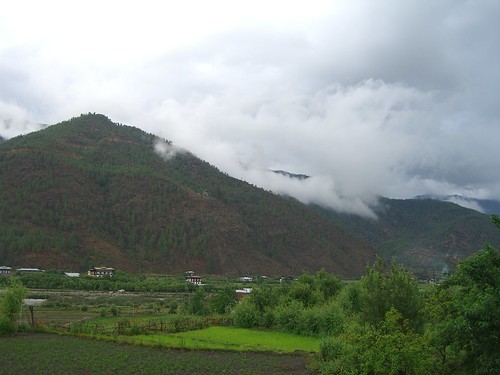
And the mountains are very dramatic. Steep and tall; frequently 1500 meters from valley floor to ridgeline and often as much as 2500 meters. There is only one airport in the country because there is only one valley with a long enough flat area for a runway and enough room between the mountainsides to enable an aircraft to maneuver as it winds its way on approach.
The mountains and altitude make for variable winds and unpredictable weather. So much so, that the two flights into Bhutan both come in the early morning, when the winds are more predictable. Let me tell you, when the fasten seatbelt sign comes on for landing here, nobody questions the wisdom of complying.
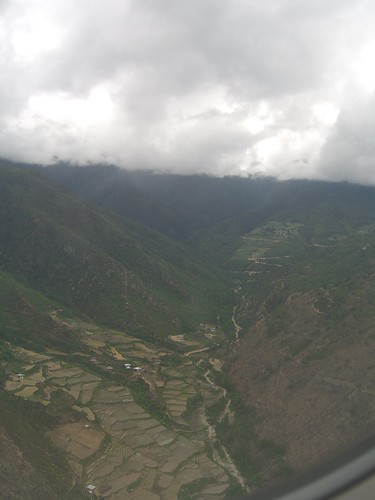
This is also a forest country. Unlike Tibet, the more famous Himalayan Kingdom, Bhutan gets significant rainfall. While Tibet is in the rain shadow of the grandest peaks, Bhutan benefits from the warm wet air that comes up from the Indian Ocean. When the warm, wet air ultimately collides with the Himalayas and is forced up it releases its load of water, no longer able to carry such a heavy load in the thin air. Much falls as snow in the extreme elevations, but quite a bit comes as rain in the inhabited ranges. The result steep mountainsides covered in dense forests, and clear, powerful rivers in every valley.
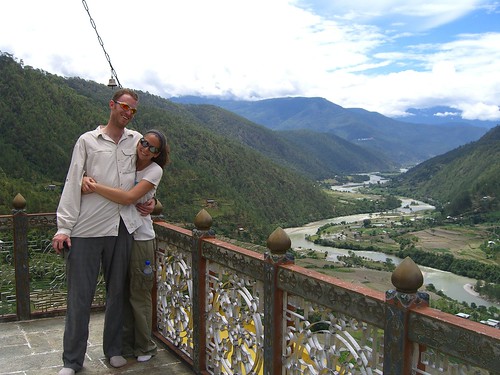
Bhutan has biodiversity and biodensity that is more reminescent of tropical rainforests. It's chief export is hydroelectrical energy. The buildings here all follow a traditional architecture. In most examples a mud brick base supports one or two stories and is painted white. This foundation is often only three sided on the second story.

Windows and the fourth side on the upper level (or the entire third story, where it exists) is made of wood, and painted with bright colors in intricate patters. The walls are crowned with interlocking beams that flange out from the wall, giving a stepped overhang before the roof (and a kind of very intricate crown moulding effect inside). From a distance the more intricate paintings blur together taking the hue of a dark stained wood, and the buildings become a bright white and rich-wood brown.

The whole Kingdom of Bhutan has fewer than 700,000 residents. Farmers and some nomads inhabit the entire range, but only the valleys host significant population concentrations. The mountains are too steep. In some of the valleys with more gentle slopes the hills have been cleared in areas for agriculture, and fields, orchards or rice paddy terraces break the shaggy green texture. But for most of the country, and for most of the view from our hillside hotel balcony there is nothing but green and blue and white.

For a damn treehugger like myself, it makes for a place so beautiful and perfect that I ache. Our first day started in Bangkok airport. We had flown in from Laos the night before, but the flight to Paro, Bhutan leaves Thailand at 4:35 am (see aforementioned need to get there before the sun heats up the valley air). By the time we cleared immigration into Thailand it was 6:00pm. With a check-in time of 2:30, taking a taxi into the city (and back out) was out of the question and spending $70 on an airport hotel that we would use for maybe five hours of sleep seemed stupid. I don't know if it was exactly smart, but we decided to just stay at the airport, eating meals slowly in the luxe lounge and uploading our backlog of photos from Mongolia at the Internet Cafe. The flight routes through Kolkutta, which seems odd at first because it's 1 hour and 40 minutes Bangkok to Kolkutta and from there about 1 hour to Paro. Plus the only other flight into Bhutan goes from Delhi (via Kathmandu). But then we heard from our captain – there is fog in Paro, and landing requires visual flight conditions. Radar just don't cut it. They didn't deplane us because it was standing-room only in the overcrowded airport, so we chilled on the plane for an hour until we got word that the weather was lifting. The short hop there helped us ensure we made what might have been a brief window of opportunity without circling high above the Himalayas. Ah, so that's why we stopped over. The appoach was, as promised, stunning.

Before final we could see over the clouds to the giant snowcapped peaks (higher still than us). It wasn't clear enough to see Everest, but we did see the third highest peak in the world.
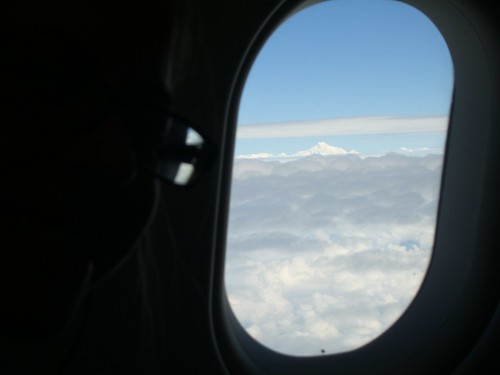
At first it just looks like a cloud – then you realize it's snow on rock. The final approach broke through the cloud layer, and we were treated to our first views of green hillsides and sky reflected in flooded rice paddies. At the airport, our guide and our driver were waiting for us right on time. Tashi, our guide, was wearing the traditional Bhutanese dress and our driver, Phubu, was wearing an Eminen t-shirt. They checked us into a cute hotel overlooking the valley..

This was formerly the palace of a local governor, and it is positioned exactly opposite from the fortress-monastery that is and was the administrative capital of the region. Our position on the hillside commands views over the broad valley.
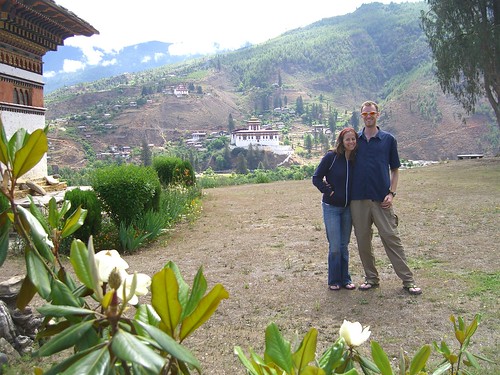
A swift river splits the center. Huddled along the banks of the river and seemingly floating on the rice paddies that surround it is a string of buildings that are considered the “city”. The whole valley has fifty-thousand residents, making Paro a city, but the city part looks like it would fit in a giant's shoebox. It's all very scenic and we could have easily enjoyed the view for hours over the fresh tea they brought us, but frankly the most welcome view of all was two soft beds.
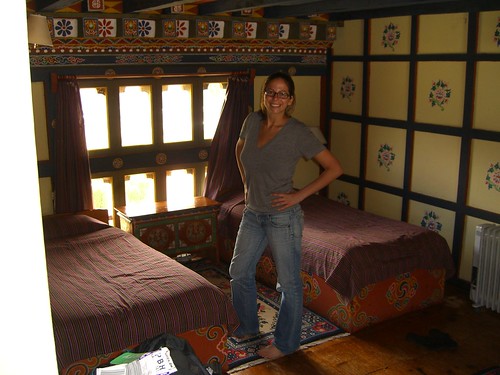
By no means recovered, we rose from our naps sufficiently rested that our excitement would keep up through the day. First priority was lunch.
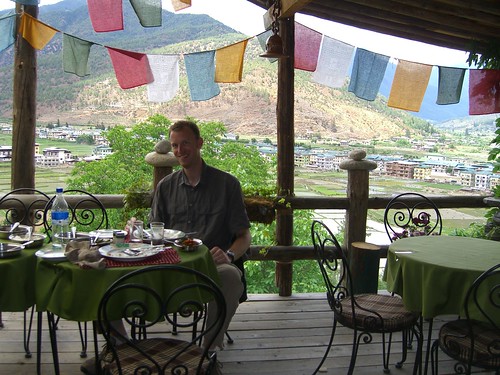
We were pleasantly surprised by a feast consisting of a dizzying array of dishes completely foreign to us. I recognized some ingredients, but the flavors derived therefrom were wholly novel. I figured that they wanted to “wow” the new visitors with their first meal and introduce them to both the Bhutanese hospitality and cuisine. In fact, this would be the first of many elaborate meals. We again met our guide, Tashi, and driver Purbu, and were off to visit some sights.
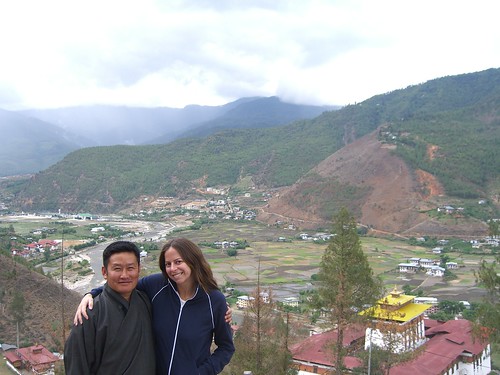
It's a direct view across the valley to the Zhong and it's watchtower (now a museum) but the serpintine route down and back up the mountainside took 7 kilometers. The roads here are paved, but almost exclusively one lane. I will never get comfortable with the constant game of chicken, the deftness with which local drivers always seem to know exactly when they have to swerve, and their confidence that their estimates for the width and load capacity of the dirt shoulders. Our first stop is the Bhutan Museum.
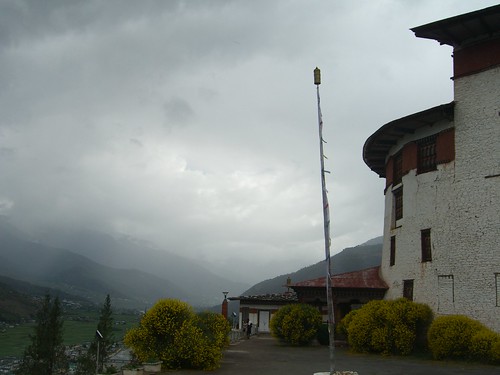
Housed in what was once a sort of over-watchtower for the Zhong below. The museum provided samples of traditional and religious art, an exhibit of photographs of all the Kings of Bhutan (there have been 5 since the establishment of the monarchy in 1908), taxidermic example of local fauna, and a few artifacts of prehistory. The curation was passable, but Tashi, our guide, was outstanding. We would later learn that to become a tour guide in Bhutan requires the equivalent of a masters degree in the history, religion, mythology, biology, anthropology and politics of the Kingdom. But our guide was much more enthusiastic about offering knowledge than the other guides we saw accompanying the few other visitors. On several occasions when I asked questions about something, I saw folks bending an ear to get his much more complete, much richer explanations of things. Basically we struck tour guide gold.

Newly versed in the history and mythology of Bhutan, we took a short trip down the hill (again, via the necessesarily serpintine roads) so we could visit the Paro Zhong. Now, I should explain this. A Zhong is built as a fortress. A large central tower is surrounded by fortified stone walls, creating a large courtyard inside. Both the central tower and the surrounding buildings provide functional space. Historically, Bhutan was unified under a Head Abbot, with local lay aristocrats installed as “Governors” who ruled each region. But the bureacratic administration of the country was done by the monks. Today the “monk system” has been replaced by a civil service under the King. But the Zhongs still serve as both government buildings and monasteries.
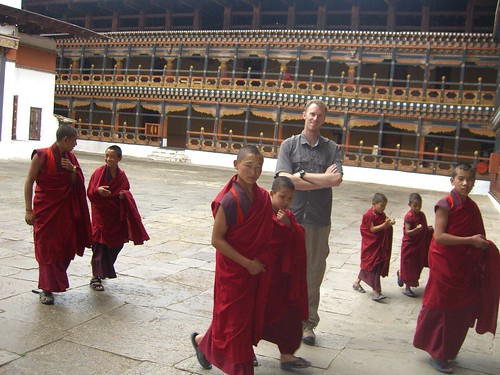
Every Zhong will house both civil and religious functions but only the monks are in literal residence.

Before we could enter the Zhong, our guide had to add a sort of sash to his traditional national dress. Many sights require Bhutanese to wear traditional “National Dress” when entering, including all the monasteries. The more formal attire is required whenever a local enters a building flying the national flag – essentially Zhongs and palaces.
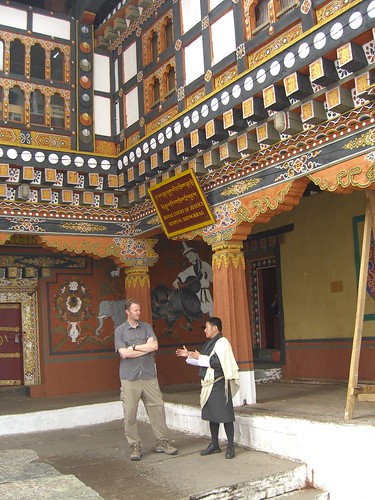
At first the traditional garb struck me as a sort of funny variant of the Mongolian attire. For men the woolen robe hangs to only just above the knee. Dress shoes are worn, with high socks that nearly reach the knee. Like so many things before, understanding of the form only wanted the opportunity to witness the function. The Himalayan climate is extremely variable, and when heat would cause Susan and me to tie our jackets around our waists, Tashi would roll down his jacket top, and tuck in his sleeves. On the (few) rainy days we had, he could tuck an umbrella into the back, held fast by the wool and ready when needed.
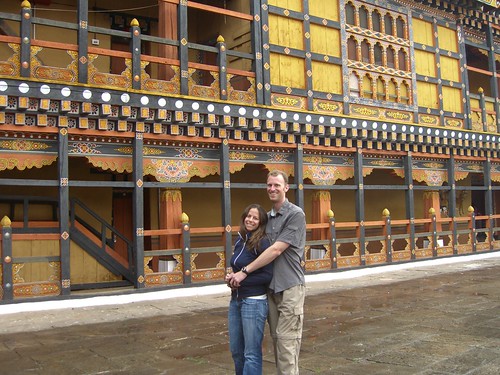
The Zhong itself was very beautiful. These are the most important buildings in Bhutan, and hence the entire structure is very ornate. Plus, Susan got many chances to indulge her eternal “monk-crush”. She keeps telling me to cut my hair really short. I think I'm lucky the monks are forbidden women. When we asked how old the monks would be, Tashi asked them for us.
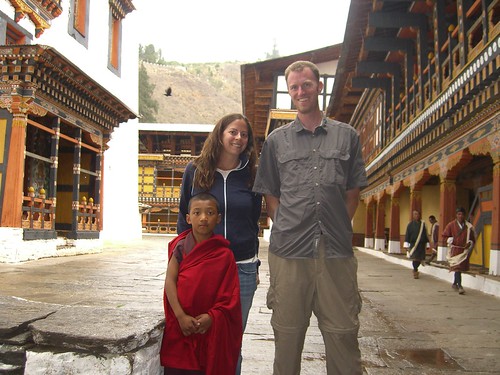
For the remainder of our visit he took a sampling census. Again, tour guide gold. Often I think Susan and I are hesitant to interrupt locals, to strike up a conversation. We want to be observers, but with the minimum possible imposition, always aware of the stereotype of the ugly American, painfully cautious about being impolite. The encouragement (and often, initiative) of Tashi really helped us navigate through these situations and get way more out of them.
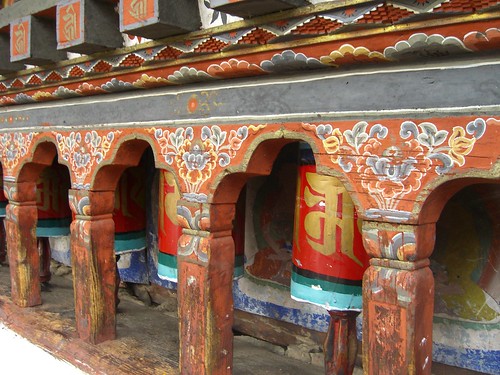
From the Zhong we went to an 11th century monastery, built before Bhutan was Bhutan by a Tibetan King who constructed 108 temples throughout Himalaya.
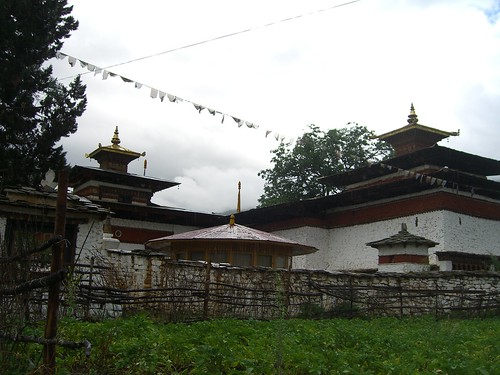
According to legend, each one pins down a defeated demon. It was cool and old, with lots of Buddhist iconography. I got really into this during my time here, and Tashi never tired of identifying subjects, explaining symbols, or relaying the legends behind them. But I think Susan, who wasn't being paid to indulge my inner 3-year old (“why why why”), gets the medal for patience. I should mention that you can't take photos inside of Buddist temples. Here the prohibition is posted, as it was in Japan. But in Buddist tradition any reproduction of the sacred image is also sacred. As such to take a photo and not treat it as a relic would be sacreligious. So, we haven't done this anywhere on the trip, and have no photos of the insides of these places to show you. Sorry.
We had a couple of hours to crash before dinner at the hotel. Dinner was lunch, but more so, and Tashi had them add the traditional Bhutanese dish of chilis and cheese. Chilis here are eaten as a staple vegetable, and traditionally chilis and cheese are served with every meal; breakfast lunch and dinner. It was very tasty, and not as spicy as one might suspect.